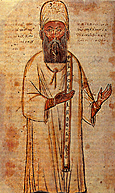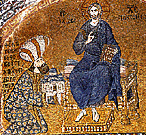 |
|
 |
The exact sciences and medicine
 uring
the 14th century, interest in mathematics, astronomy, engineering and medicine became especially lively. uring
the 14th century, interest in mathematics, astronomy, engineering and medicine became especially lively.
 The
ground had already been prepared since the 13th century by the writings of
Nikephoros Blemmydes,
Maximos Planoudes and George
Pachymeres on mathematics and physics, a work that was carried on in the 14th century by a great many scholars.
Manuel Moschopoulos,
Nicholas Rabdas and
John Pediasimos wrote mathematical treatises,
Barlaam de Seminara wrote treatises
on logistics, and the physicians
Gregory Chioniades and
George Chrysokokkes showed an interest in Persian mathematics and astronomy.
Isaac Argyros,
Theodore Meliteniotes, Theodore Metochites,
Nikephoros Choumnos and Nikephoros Gregoras also wrote treatises on astronomy.
Joseph Rhakendytes produced The
ground had already been prepared since the 13th century by the writings of
Nikephoros Blemmydes,
Maximos Planoudes and George
Pachymeres on mathematics and physics, a work that was carried on in the 14th century by a great many scholars.
Manuel Moschopoulos,
Nicholas Rabdas and
John Pediasimos wrote mathematical treatises,
Barlaam de Seminara wrote treatises
on logistics, and the physicians
Gregory Chioniades and
George Chrysokokkes showed an interest in Persian mathematics and astronomy.
Isaac Argyros,
Theodore Meliteniotes, Theodore Metochites,
Nikephoros Choumnos and Nikephoros Gregoras also wrote treatises on astronomy.
Joseph Rhakendytes produced
 the first great "encyclopaedia" in Byzantium, the Synopsis en Epitome, which synoptically presents the essential elements of each science. Finally, the medical treatises that have survived are of great interest, because of what they tell us concerning the diseases that afflicted the people during
that period. Nikephoros Blemmydes wrote about blood testing and about thirteen different urine types,
Nicholas Myrepsos compiled a
list of 2,656 pharmaceutical remedies and poison antidotes.
John Zacharias
Aktouarios wrote a treatise entitled A Therapeutic Method and
Demetrios Pepagomenos wrote an
extensive work on gout, a disease that the Byzantines inherited from the Romans and of which they never succeeded in ridding themselves..
Theodore Prodromos was so impressed by the manifestations of variola (smallpox) that he described them in his letters. Finally,
Aristeides Ailios constitutes the
prototpye not only of a fine orator but also of a hypochondriac,
since his letters deal at length with various illnesses and their symptoms, a theme which provided the subject for several letters
of Gregory of Cyprus and
John Chortasmenos as well. the first great "encyclopaedia" in Byzantium, the Synopsis en Epitome, which synoptically presents the essential elements of each science. Finally, the medical treatises that have survived are of great interest, because of what they tell us concerning the diseases that afflicted the people during
that period. Nikephoros Blemmydes wrote about blood testing and about thirteen different urine types,
Nicholas Myrepsos compiled a
list of 2,656 pharmaceutical remedies and poison antidotes.
John Zacharias
Aktouarios wrote a treatise entitled A Therapeutic Method and
Demetrios Pepagomenos wrote an
extensive work on gout, a disease that the Byzantines inherited from the Romans and of which they never succeeded in ridding themselves..
Theodore Prodromos was so impressed by the manifestations of variola (smallpox) that he described them in his letters. Finally,
Aristeides Ailios constitutes the
prototpye not only of a fine orator but also of a hypochondriac,
since his letters deal at length with various illnesses and their symptoms, a theme which provided the subject for several letters
of Gregory of Cyprus and
John Chortasmenos as well.
See also: George Pachymeres,
Nikephoros Gregoras,
Theodore Metochites
|